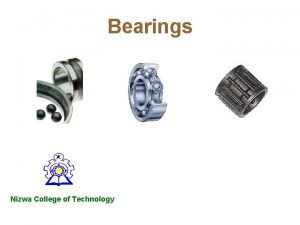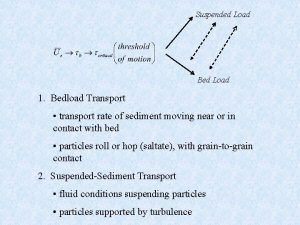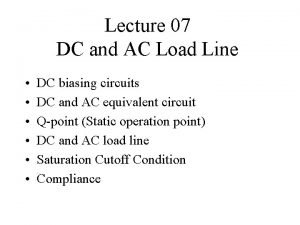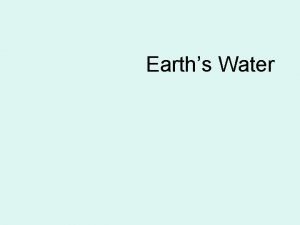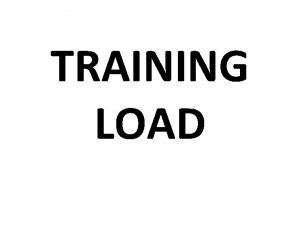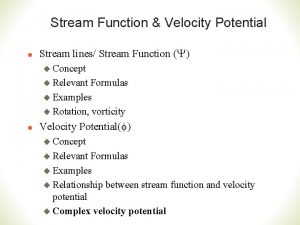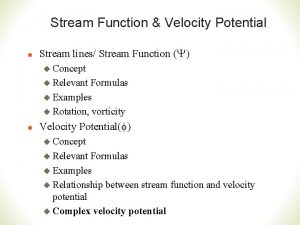Stream Water Stream Load Stream Load everything carried

















- Slides: 17

Stream Water

Stream Load • Stream Load – everything carried by stream water, both living and non-living – Living – bacteria, algae, fish, etc. – Non-living – Sediment, dissolved gases (like oxygen), etc.

Stream Load • Biotic Index – a scale for showing a stream’s quality based on the types of organisms living in it • Measured from 1 (excellent) to 10 (poor)

Stream Load • How is biotic index calculated? • The tester collects macro (visible to the naked eye) invertebrates from portions of the stream and then groups them and counts them • Some organisms are more sensitive to pollution than others, so if they are present in the water, the scientist can assume the water is fairly clean Mayfly nymph – very sensitive to pollution, so the water must be clean!

Stream Load • Homogeneous mixture (solution) – mixture where you cannot see the individual parts – Example: sugar water – Ex: dissolved minerals in stream water • The amount of particles dissolved in a solution is measured in parts per million (ppm)

Stream Load • Heterogeneous mixture – a mixture where you CAN see the individual parts • Suspension – particles are visible, but small enough to stay mixed in the moving water – Example: sediments in a stream

Carrying Capacity • Carrying capacity – how much a stream can hold – The greater the stream’s volume, the more it can carry – The faster the stream’s speed, the more it can carry

Carrying Capacity • Fast-moving water can carry heavier particles than slow-moving water • As the water slows down, the heavy particles settle to the bottom Fast-moving water All sediments moving Slow-moving water Heavy sediments sink

Check for Understanding Stream Load -- WHAT a stream carries • _______ • Carrying ________ Capacity -- HOW MUCH a stream carries Stream Load Bed Load

Bed Load • Bed Load – sediment rolled or pushed along the bed (bottom) of a stream • Creep – rolling motion • Saltation – bouncing motion

Bed Load • Abrasion – when moving particles bump into each other and scrape each other • Causes the particles to be physically ____ weathered, which makes them rounder and smoother than before

Depositional Features • As a stream slows down, more and more sediments are deposited • Over time, stream deposition can create landforms

Depositional Features • Delta – a triangular deposit of sediment located where a fast-moving stream flows into a larger body of slow-moving water • Named after the Greek letter delta -- ∆ Nile River Delta

Depositional Features • Example: Nile River Delta, where the Nile River empties into the Mediterranean Sea • About 39 million people live in the Nile River Delta, which is well-known for its agriculture • Why? Nile River Delta

Depositional Features • Alluvial Fan – a fan-shaped deposit of sediment at the flat base of a mountain • Water flows down the mountain and then slows down and deposits sediment at the base


 Water and water and water water
Water and water and water water Thrust load bearing
Thrust load bearing Red dot
Red dot Suspended load definition
Suspended load definition Difference between ac load line and dc load line
Difference between ac load line and dc load line Stream load
Stream load Stream load
Stream load What is stream load?
What is stream load? Differentiate byte stream and character stream
Differentiate byte stream and character stream Returns outwards
Returns outwards Speaking of courage questions
Speaking of courage questions The things they carried controversy
The things they carried controversy The things they carried quotes
The things they carried quotes The things they carried themes
The things they carried themes Acrostic poem on teamwork
Acrostic poem on teamwork Syntax in the things they carried
Syntax in the things they carried The things they carried pov
The things they carried pov Balance carried down
Balance carried down

